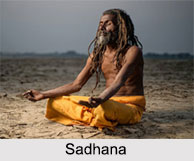 Sadhana is a process of spiritual growth. Sadhana is a broad term coming from the yogic tradition and it consigns to any religious exercise that is aimed at systematic "sadhaka" towards the ultimate turn of phrase of his or her life. It is basically a daily spiritual practice designed to permit one to turn innermost and recognize life. Sadhana does not mean any precise kind of movement. Sadhana means an individual is using everything as a tool for his or her health.
Sadhana is a process of spiritual growth. Sadhana is a broad term coming from the yogic tradition and it consigns to any religious exercise that is aimed at systematic "sadhaka" towards the ultimate turn of phrase of his or her life. It is basically a daily spiritual practice designed to permit one to turn innermost and recognize life. Sadhana does not mean any precise kind of movement. Sadhana means an individual is using everything as a tool for his or her health.
The main object of Sadhana is primarily to gain control over mind. According to spiritual canons, to realise God or to achieve "moksha", it is essential to gain control over mind and detach oneself from the material desires. Sadhana could be a mantra meditation, a definite yogic asana exercise, a particular kriya, a visualisation or a daily walk in nature.
Etymology of Sadhana
The word Sadhana literally means realising an end through spiritual practices. Sadhana factually means of accomplishing something.
Sadhana in Religions
Sadhana is a practice which is prevalent in both Hinduism and Buddhism. Traditionally in order to get on on a specific path of Sadhana, a guru may be required to present the necessary trainings. This way is characterized by some Tantric traditions. On the other hand, individual pronounces may build up their own spiritual tradition without participating in planned groups. In Hinduism, Sadhana and abhyasa (practice) are considered similar. In fact Sadhana is a lifelong practice and hence, requires lot of patience. Some people have the notion that they can attain psychic powers by simple yogic practices. However, the truth is that simple yogic practices cannot help one to achieve Siddhis or psychic powers.
Inquisitiveness about spirituality is merely a stepping stone for the spiritual progress. One needs to introspect, analyse, pray, practice Japa, meditate and attained Satnangs to quench their curiosity. Religious texts are also considered good means for spiritual guidance. There are 15 major tantric Sadhanas in Buddhism namely Surangama/Sitatapatra, Nilakantha, Tara, Mahakala, Hayagriva, Amitabha, Aksobhya, Guhyasamaja, Vajravarahi, Cakrasamvara, Yamantaka, Kalacakra, Hevajra, Chod and Vajrapani.
In Hinduism, Sadhana and abhyasa (practice) are considered similar. In fact Sadhana is a lifelong practice and hence, requires lot of patience. Some people have the notion that they can attain psychic powers by simple yogic practices. However, the truth is that simple yogic practices cannot help one to achieve Siddhis or psychic powers. Inquisitiveness about spirituality is merely a stepping stone for the spiritual progress. One needs to introspect, analyse, pray, practice Japa, meditate and attained Satnangs to quench their curiosity. Religious texts are also considered good means for spiritual guidance. There are different kinds of Sadhana in both Buddhism and Hinduism. It depends on the individual which kind of Sadhana he wants to practice.
One of the prerequisites of Sadhana is the right action. Intention alone is not sufficient. It has to be complemented by right action via right means. This yogic practice is the path to attain Self knowledge and for this purpose it requires best intentions. Ethical clarity and spiritual progress are two sides of the same coin and these form the first step towards attaining spirituality. Sadhana also requires exercise of self discipline, meaning that one needs to stay away from brutality. One of the innate qualities of man is considered to be humaneness and it is important that he practices too.
Precautions for Sadhana:
There are some precautions for practicing Sadhana and these are as follows:
•A person who is practicing Sadhana should not mix much with others.
•He should not speak much.
•Eat as is required.
•Do not sleep for too long.
•Avoid the company of women.
•Avoid residing with householders.
•Do not feel discouraged by failures.
•Be patient.
•Resist all kinds of temptations.
•Do not get deluded by initial successes.
•Practice Sadhana regularly.
These precautions are recommended so that the person practicing Sadhana is not affected by external or internal disturbances. For instance, talking would distract the mind and hamper concentration. On the other eating too much leads to drowsiness.
Sadhana is an elaborated process as it takes time to awaken supra consciousness of Brahman. It must always be remembered that there is no easy way to achieve realize the self. Spiritual development takes place gradually in a slow pace and the sadhaka needs to strive harder each time to attain his end.




















